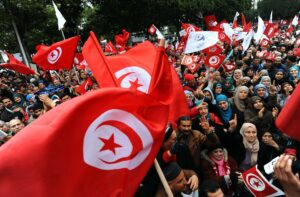Nonviolent resistance, also called active nonviolence, became popular in the early twentieth century when Ghandi1, based on the ideology of Tolstoy and Thoreau made use of a series of disobedience and non collaboration tactics that resulted in the independence of India and Pakistan from the British Empire2. This form of activism continued to be common throughout the twentieth century and would be the preferred form of operation of the anti-globalization movement to this day.
By the end of the twentieth century, the processes of globalization are accelerating. In this context, institutions (G8, Davos Forum, WTO…)3 emerge without any kind of democratic control that decisively influence how the economy or politics are configured, without taking into account the rights of the people affected or the effects on the environment.
In response to this process and neo-liberal policies, the anti-globalization movement emerged, focusing on denouncing the inequalities created by these policies and the predatory development that destroys the environment. The turning point of this movement came in 1999, with the so-called Battle of Seattle4, which managed to thwart a WTO5 summit through actions of blockade, sit-ins and demonstrations, which paved the way for the voices from the South (G20) questioning WTO6 trade policies.
Nonviolence has since become an inseparable part of the struggles that will run throughout the 21st century until today, for example in the counter-summit against the G8 in Genoa, where different groups tried to enter the exclusion zone using plastic shields7. Towards 2010 a series of revolutions and protests, known as a whole as the Arab Spring, arose in North and Middle East Africa8, which through peaceful mobilizations and blockades managed to shake up regimes for decades. The second decade of the 21st century also saw the rise of the 15M9 or the Occupy movement, which changed the way we understand politics in the Western world by focusing on more democracy and social justice.
These are just a few examples of movements that advocated active nonviolence tactics. The third decade of the 21st century will present challenges for the betterment of human rights and the protection of the environment, but in India they have not forgotten these tactics and are currently holding a historic mobilization10 against President Modi’s neo-liberal agenda.
1 https://oxford.universitypressscholarship.com/view/10.1093/acprof:oso/9780190491451.001.0001/acprof-9780190491451-chapter-9
2 https://www.lavanguardia.com/historiayvida/20191206/472018308412/gandhi-india-independencia-discurso-no-violencia-desobediencia-civil.html
3 https://web.archive.org/web/20170518033322/http://www.nber.org/reporter/winter00/krueger.html
4 https://www.historylink.org/File/2143
5 https://web.archive.org/web/20090804173136/http://www.tradeobservatory.org/headlines.cfm?refID=16997
6 https://www.wto.org/english/tratop_e/dda_e/negotiating_groups_e.pdf
7 https://web.archive.org/web/20060511103543/http://www.dalbasso.org/informe.htm
8 https://www.fundeu.es/recomendacion/primavera-arabe-en-letra-redonda-y-con-minusculas-961/
9 https://www.publico.es/sociedad/15-m-cambio-vida.html
10 https://www.newsclick.in/Farmers-Movement-Spreads-Over-300-Protest-Sites-Telugu-States
More Information:
Handbook for Nonviolent Campaigns
Become Interest:
MEXICO JUDGE ITS FORMER PRESIDENTS
ERDOĞAN AND THE NEO-OTOMANIST DELUSION



One Response
VACCINATE COVID-19: A LUXURY FROM RICH COUNTRIES? - IN ACTION)))
[…] ACTIVE NONVIOLENCE: A PULSE TO NEO-LIBERALISM […]